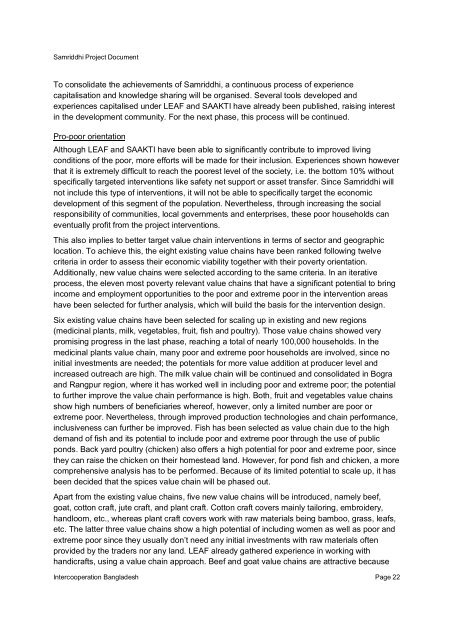Samriddhi
Samriddhi
Samriddhi
Create successful ePaper yourself
Turn your PDF publications into a flip-book with our unique Google optimized e-Paper software.
<strong>Samriddhi</strong> Project Document<br />
To consolidate the achievements of <strong>Samriddhi</strong>, a continuous process of experience<br />
capitalisation and knowledge sharing will be organised. Several tools developed and<br />
experiences capitalised under LEAF and SAAKTI have already been published, raising interest<br />
in the development community. For the next phase, this process will be continued.<br />
Pro-poor orientation<br />
Although LEAF and SAAKTI have been able to significantly contribute to improved living<br />
conditions of the poor, more efforts will be made for their inclusion. Experiences shown however<br />
that it is extremely difficult to reach the poorest level of the society, i.e. the bottom 10% without<br />
specifically targeted interventions like safety net support or asset transfer. Since <strong>Samriddhi</strong> will<br />
not include this type of interventions, it will not be able to specifically target the economic<br />
development of this segment of the population. Nevertheless, through increasing the social<br />
responsibility of communities, local governments and enterprises, these poor households can<br />
eventually profit from the project interventions.<br />
This also implies to better target value chain interventions in terms of sector and geographic<br />
location. To achieve this, the eight existing value chains have been ranked following twelve<br />
criteria in order to assess their economic viability together with their poverty orientation.<br />
Additionally, new value chains were selected according to the same criteria. In an iterative<br />
process, the eleven most poverty relevant value chains that have a significant potential to bring<br />
income and employment opportunities to the poor and extreme poor in the intervention areas<br />
have been selected for further analysis, which will build the basis for the intervention design.<br />
Six existing value chains have been selected for scaling up in existing and new regions<br />
(medicinal plants, milk, vegetables, fruit, fish and poultry). Those value chains showed very<br />
promising progress in the last phase, reaching a total of nearly 100,000 households. In the<br />
medicinal plants value chain, many poor and extreme poor households are involved, since no<br />
initial investments are needed; the potentials for more value addition at producer level and<br />
increased outreach are high. The milk value chain will be continued and consolidated in Bogra<br />
and Rangpur region, where it has worked well in including poor and extreme poor; the potential<br />
to further improve the value chain performance is high. Both, fruit and vegetables value chains<br />
show high numbers of beneficiaries whereof, however, only a limited number are poor or<br />
extreme poor. Nevertheless, through improved production technologies and chain performance,<br />
inclusiveness can further be improved. Fish has been selected as value chain due to the high<br />
demand of fish and its potential to include poor and extreme poor through the use of public<br />
ponds. Back yard poultry (chicken) also offers a high potential for poor and extreme poor, since<br />
they can raise the chicken on their homestead land. However, for pond fish and chicken, a more<br />
comprehensive analysis has to be performed. Because of its limited potential to scale up, it has<br />
been decided that the spices value chain will be phased out.<br />
Apart from the existing value chains, five new value chains will be introduced, namely beef,<br />
goat, cotton craft, jute craft, and plant craft. Cotton craft covers mainly tailoring, embroidery,<br />
handloom, etc., whereas plant craft covers work with raw materials being bamboo, grass, leafs,<br />
etc. The latter three value chains show a high potential of including women as well as poor and<br />
extreme poor since they usually don’t need any initial investments with raw materials often<br />
provided by the traders nor any land. LEAF already gathered experience in working with<br />
handicrafts, using a value chain approach. Beef and goat value chains are attractive because<br />
Intercooperation Bangladesh Page 22
















